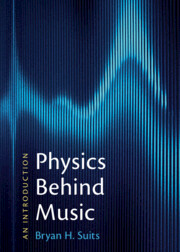Refine search
Actions for selected content:
36808 results in Cambridge Textbooks
Part I - Loss Models
-
- Book:
- Nonlife Actuarial Models
- Published online:
- 07 July 2023
- Print publication:
- 25 May 2023, pp 1-102
-
- Chapter
- Export citation
Conclusion
- from Part III - What about Causality?
-
- Book:
- The Grammar of Time
- Published online:
- 11 May 2023
- Print publication:
- 25 May 2023, pp 183-190
-
- Chapter
- Export citation
References
-
- Book:
- Nonlife Actuarial Models
- Published online:
- 07 July 2023
- Print publication:
- 25 May 2023, pp 530-531
-
- Chapter
- Export citation

Physics Behind Music
- An Introduction
-
- Published online:
- 24 May 2023
- Print publication:
- 06 April 2023
-
- Textbook
- Export citation
5 - Statehood, self-determination and territory
-
-
- Book:
- Public International Law
- Published online:
- 09 May 2023
- Print publication:
- 23 May 2023, pp 107-141
-
- Chapter
- Export citation
About the authors
-
- Book:
- Public International Law
- Published online:
- 09 May 2023
- Print publication:
- 23 May 2023, pp xxii-xxiv
-
- Chapter
- Export citation
Preface
-
- Book:
- Public International Law
- Published online:
- 09 May 2023
- Print publication:
- 23 May 2023, pp xxv-xxv
-
- Chapter
- Export citation
Copyright page
-
- Book:
- Public International Law
- Published online:
- 09 May 2023
- Print publication:
- 23 May 2023, pp iv-iv
-
- Chapter
- Export citation
Acknowledgement of Country
-
- Book:
- Public International Law
- Published online:
- 09 May 2023
- Print publication:
- 23 May 2023, pp ii-ii
-
- Chapter
- Export citation
Abbreviations
-
- Book:
- Public International Law
- Published online:
- 09 May 2023
- Print publication:
- 23 May 2023, pp lxxiii-lxxiv
-
- Chapter
- Export citation
Table of treaties and other international instruments
-
- Book:
- Public International Law
- Published online:
- 09 May 2023
- Print publication:
- 23 May 2023, pp xliv-lxxii
-
- Chapter
- Export citation
Index
-
- Book:
- Public International Law
- Published online:
- 09 May 2023
- Print publication:
- 23 May 2023, pp 465-474
-
- Chapter
- Export citation
12 - International criminal law
-
-
- Book:
- Public International Law
- Published online:
- 09 May 2023
- Print publication:
- 23 May 2023, pp 320-345
-
- Chapter
- Export citation
6 - Jurisdiction and immunities
-
-
- Book:
- Public International Law
- Published online:
- 09 May 2023
- Print publication:
- 23 May 2023, pp 142-179
-
- Chapter
- Export citation
11 - International humanitarian law
-
-
- Book:
- Public International Law
- Published online:
- 09 May 2023
- Print publication:
- 23 May 2023, pp 294-319
-
- Chapter
- Export citation
Glossary
-
- Book:
- Public International Law
- Published online:
- 09 May 2023
- Print publication:
- 23 May 2023, pp 456-464
-
- Chapter
- Export citation
Table of statutes
-
- Book:
- Public International Law
- Published online:
- 09 May 2023
- Print publication:
- 23 May 2023, pp xli-xliii
-
- Chapter
- Export citation
4 - International law and Australian law
-
-
- Book:
- Public International Law
- Published online:
- 09 May 2023
- Print publication:
- 23 May 2023, pp 83-106
-
- Chapter
- Export citation
15 - International organisations
-
-
- Book:
- Public International Law
- Published online:
- 09 May 2023
- Print publication:
- 23 May 2023, pp 400-429
-
- Chapter
- Export citation
8 - Use of force
-
-
- Book:
- Public International Law
- Published online:
- 09 May 2023
- Print publication:
- 23 May 2023, pp 212-237
-
- Chapter
- Export citation
